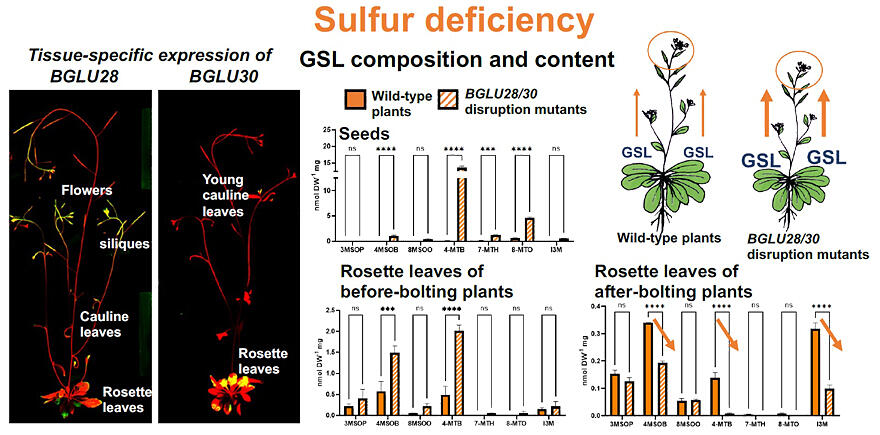Plants take up sulfur as sulfate ions and synthesize compounds that are useful to humans, such as amino acids and proteins. The functional sulfur-containing metabolites 'glucosinolates' and their degradation products 'isothiocyanates' (e.g., sulforaphane), which are produced by plants of the order Brassicales are used to repel pests. In humans, these prevent carcinogenesis and various inflammatory diseases and are used in functional foods and dietary supplements. Because glucosinolates contain many sulfur atoms in their molecular structure, they are used by plants for sulfur storage. When plants are exposed to low sulfur environments, glucosinolate degradation is accelerated, and the resulting sulfate ions are used to synthesize other sulfur-containing metabolites essential for growth.
A research group led by Graduate Student Liu Zhang and Associate Professor Akiko Maruyama-Nakashita of the Graduate School of Bioresource and Bioenvironmental Sciences at Kyushu University, in collaboration with Saga University and the University of Copenhagen, has shown that deletion of the glucosinolate-degrading enzymes myrosinases (BGLU28 and BGLU30) suppresses plant growth and alter the distribution of glucosinolates in the plant body. The results have been published online in Plant & Cell Physiology.

Provided by Kyushu University
The research group produced plants deficient in BGLU28 and BGLU30 and measured the amount of glucosinolates in their leaves and seeds under sulfur-deficient conditions. The glucosinolate level was increased in the plants, pods, seeds, and leaves before stem elongation. This is thought to be due to suppressed decomposition. Surprisingly, the leaf glucosinolates decreased as the stem began to elongate.
Since there was no change in the expression of biosynthetic genes, the plants were analyzed for possible enhanced glucosinolate transport from the leaves. It was found that glucosinolate transport to the flowers and sheaths was indeed enhanced in the myrosinase- deficient plants grown under sulfur deficiency.
Analysis of the expression of the previously known glucosinolate transporters GTR and UMAMIT revealed that the transcription product levels of GTR3, UMAMIT30, and UMAMIT31 in particular were increased in the myrosinase-deficient strains grown under sulfur deficiency.
Using RNA sequencing to analyze the effects of BGLU28 and BGLU30 deficiency on other metabolic systems, the research group found that the transcription product levels of proteins involved in chaperoning, disease resistance and ethylene responses were also altered, suggesting that the inability to degrade glucosinolates affects multiple biological processes.
This is a new discovery regarding the mechanisms that alter the distribution of metabolites in response to environmental conditions and plant developmental processes, as well as the regulation of the accumulation of beneficial compounds.
There are many types of vegetables belonging to the order Brassicales, including Chinese cabbage, cabbage, Japanese mustard spinach, and broccoli, the consumption of which is expected to prevent disease. The research group hopes to apply these results to technology for regulating the amount of glucosinolates in crops.
Zhang explained, "We have found that the inhibition of glucosinolate degradation affects its transport in sulfur-deficient plants. Plants optimize the distribution of functional metabolites in response to environmental changes, and we believe that they have more sophisticated regulatory mechanisms than we could have imagined."
Journal Information
Publication: Plant & Cell Physiology
Title: Glucosinolate catabolism maintains glucosinolate profiles and transport in sulfur-starved Arabidopsis
DOI: 10.1093/pcp/pcad075
This article has been translated by JST with permission from The Science News Ltd. (https://sci-news.co.jp/). Unauthorized reproduction of the article and photographs is prohibited.




